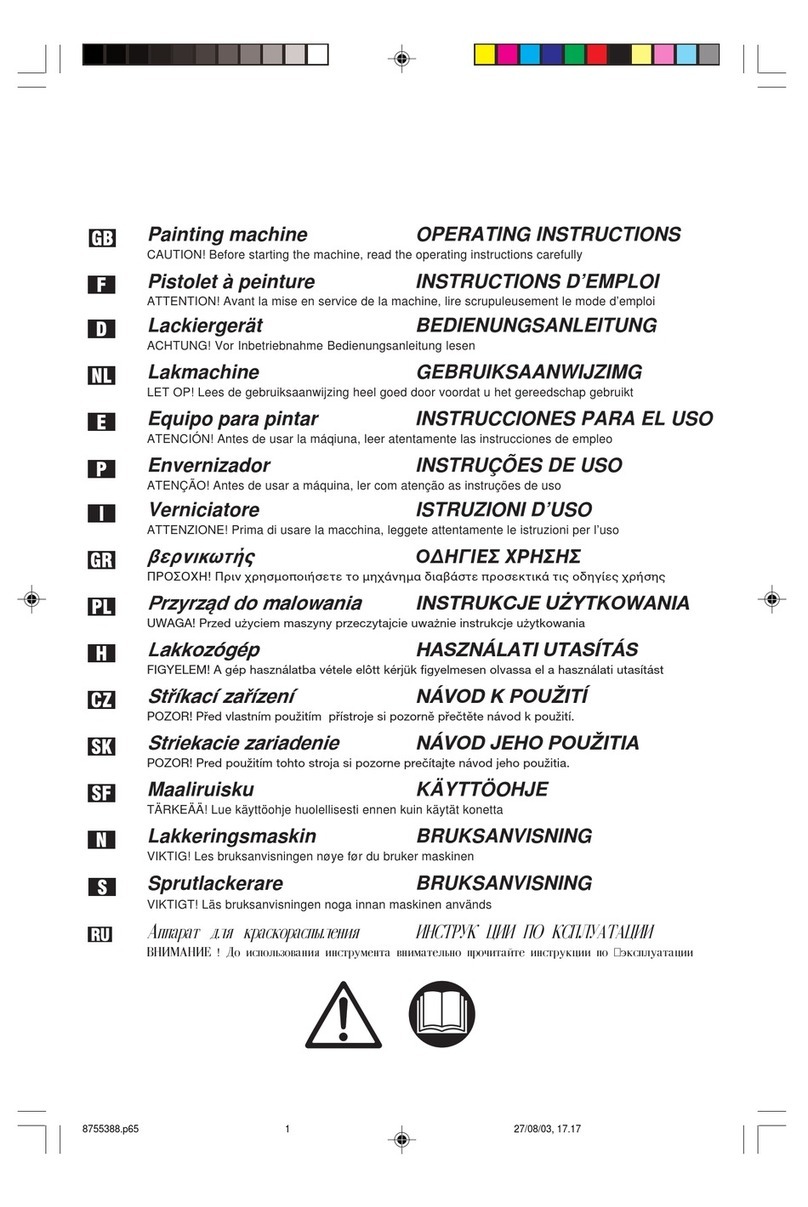
- 9 -
MESSA IN SERVIZIO (FIG. C)
L’apparecchio può essere fornito con alcuni
componenti smontati. Estraete l’apparecchio ed
i componenti forniti smontati dalla confezione e
procedete al loro assemblaggio come illustrato.
Durante le fasi di assemblaggio dei componenti,
la batteria deve essere scollegata dall’apparec-
chio. Prima di avviare l’apparecchio verificare la
solidità dell’assemblaggio.
CARICA DELLA BATTERIA (Seguire le istruzioni
allegate al caricabatterie)
ATTENZIONE! Prima di utilizzare l’appa-
recchio è necessario effettuare una carica
completa della batteria.
ATTENZIONE! Ricaricare soltanto con
un caricabatterie previsto per questo tipo di
apparecchio. Un caricabatterie che è adeguato
per un tipo di gruppo di batterie può creare un
rischio di incendio quando viene utilizzato con
altri gruppi di batterie.
Per mantenere efficiente la batteria, non
scaricarla completamente.
Eseguite una successiva ricarica completa:
- Dopo ogni utilizzo.
- Almeno ogni 4 mesi, anche in caso di inutilizzo.
- Se durante il lavoro notate un calo evidente
delle prestazioni dell’apparecchio.
INSERIMENTO E RIMOZIONE DELLA BATTERIA
(Fig.D)
- Inserite la batteria attraverso le guide presenti
sull’alloggiamento batteria. (pos.7)
- Estraete la batteria dalla sede dell’utensile
agendo sul dispositivo di sgancio (pos.8)
AVVIAMENTO, ARRESTO (FIG.A)
ATTENZIONE! Prima di avviare l’utensile
elettrico è obbligatorio indossare i dispositivi
di protezione individuale (non inclusi).
- Inserire la batteria carica nell’ alloggiamento
dell’apparecchio (Pos.7).
- Per avviare l’apparecchio, premere il grilletto
della pistola a spruzzo (5 Fig.A), per arrestare
l’apparecchio e interrompere il flusso della
vernice, rilasciate il grilletto.
ISTRUZIONI D’USO
Dopo aver letto attentamente le norme di sicu-
rezza, seguite scrupolosamente queste istruzioni
che vi permetteranno di ottenere il massimo delle
prestazioni. Procedete con calma; solo dopo
aver acquisito una buona esperienza riuscirete
a sfruttarne a fondo le potenzialità. Le condizioni
di verniciatura di questo apparecchio sono di un
alto volume d’aria che avvolge il getto spruzzato
in bassa pressione, questo contribuisce ad avere
un’alta efficienza della verniciatura. Inoltre la
corrente d’aria favorisce la riduzione dei tempi
di essiccaggio del materiale di copertura.
Il disegno di Fig.D illustra le corrette posizioni e
modalità di utilizzo.
Attenzione! Per assicurare una elevata effi-
cienza dell’apparecchio ed evitare il surriscal-
damento del motore, mantenete sempre pulite
e libere le feritoie di ventilazione (3 Fig.A).
Preparazione dell’oggetto o della superficie
da trattare
Il risultato della verniciatura dipende da quanto
pulita e liscia è la superficie da trattare. Togliere
qualsiasi traccia di ruggine o incrostazione del
vecchio colore e se necessario levigarlo con
carta abrasiva. Stuccare dove necessario per
rendere le superfici ben omogenee. Liberate
la superficie dalla polvere e muffe prima di
effettuare la spruzzatura. Leggere attentamente
le istruzioni indicate sul barattolo della vernice
relative alla possibilità di passare un fissativo
prima di iniziare la verniciatura per avere un
risultato migliore e soprattutto un risparmio di
prodotto. Le superfici che non devono essere
verniciate vanno ricoperte con nastro adesivo
o carta. Proteggete il pavimento con teli.
Preparazione del materiale da spruzzare
L’apparecchio può erogare correttamente
vernici con una viscosità non superiore a
70DIN/s. Controllare sempre la viscosità della
vernice prima che venga versata nel contenitore.
Agitare bene il prodotto prima di aprire il ba-
rattolo. Il prodotto da verniciare deve essere in
generale diluito (vi raccomandiamo di fare una
prova su una parte del prodotto prima di diluirlo
tutto). Seguire le indicazioni del fabbricante del
prodotto per il tipo di diluente e la quantità da
aggiungere. Nel caso il fabbricante non indichi
come diluire il prodotto e non precisi quale
tipo di diluente usare, chiedete informazioni al
vostro fornitore di vernici specificando che il































